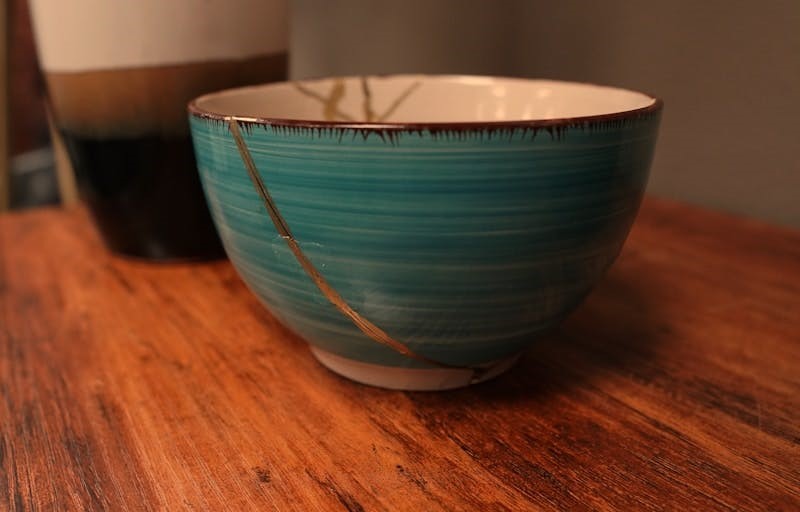This is a guest post by Prudence Sinclair.

Photo Attribute; https://unsplash.com/@mattperkins1
Hello, lovely YOU!
I recently learned about the Japanese art technique called Kintsugi and was immediately struck by what apowerful reminder it is that there is BEAUTY in IMPERFECTION!!!
The technique is used to repair broken pottery with lacquer mixed with powdered precious metals that transforms what was once broken into something startlingly beautiful and valuable. But I believe Kintsugi is more than just a method of mending ceramics; it is a profound philosophy that can be applied to personal healing and emotional recovery.
The Origins and Philosophy of Kintsugi
Kintsugi translates to “golden joinery.” I like to think it can also be translated to “golden journey, “ because often it is the moments in our life’s journey that we thought broke us that turn out to be the moments that make us shine like gold.
The artistic technique originated in Japan during the 15th century. The legend is that a famous Japanese shogun sent his favorite tea bowl back to China for repair after it had broken. When it was returned, the bowl was held together with unsightly metal staples, marring its beauty.
Displeased, the shogun sought out Japanese craftsmen who devised a more aesthetically pleasing method of repair using lacquer mixed with powdered gold. The result was a piece that was not only restored but elevated, with the cracks themselves becoming the most visually striking elements of the object.
Kintsugi is rooted in the Japanese philosophy of wabi-sabi, which finds beauty in imperfection, impermanence, and incompleteness. Rather than hiding the cracks or flaws, Kintsugi highlights them, creating a new piece that tells a story of resilience and transformation. This philosophy encourages us to see our own brokenness and imperfections as opportunities for growth and renewal.
Embracing Our Cracks: The Metaphor of Kintsugi in Personal Healing
No one gets out of this life without experiencing pain and moments of brokenness. For many, the experiences can leave us feeling fractured and incomplete, much like a broken piece of pottery.
The practice of personal Kintsugi can lead to powerful healing!
Instead of discarding the broken pieces of ourselves, we can choose to mend them with care, creating something new and beautiful from our experiences.
Just as the gold in Kintsugi emphasizes the cracks in pottery, we can embrace our emotional scars and acknowledge them as integral parts of our story. These scars do not detract from our worth; rather, they add to it. The process of healing and mending is what makes us unique and resilient.
The Process of Emotional Kintsugi
Applying the principles of Kintsugi to our personal lives involves several key steps, each of which mirrors the traditional pottery repair process:
Acknowledging the Breakage
The first step in emotional Kintsugi is to acknowledge our brokenness. This means accepting that we have been hurt and that we carry emotional scars. It’s important to be honest with ourselves and others and recognize that these experiences are part of our journey, not something to be ashamed of or to hide away.
Gather the Pieces
Just as a Kintsugi artist carefully gathers the broken pieces of pottery, we must gather the pieces of our emotional selves. This may involve reflecting on our experiences, seeking support from loved ones, or engaging in therapy. The goal is to bring all the fragmented parts of ourselves into awareness so that we can begin the process of healing.
Choosing the Gold
In Kintsugi, the gold used to mend the cracks is what gives the piece its beauty. In emotional healing, the “gold” represents the self-love, self-compassion, and understanding that we bring to our emotional injuries. It’s the element that transforms our pain into something valuable
Mending the Cracks
The act of mending involves integrating our experiences into our sense of self. This might mean reframing a painful experience as a lesson learned, or finding meaning in suffering. The key is to see our scars not as weaknesses, but as symbols of our strength and resilience.
Celebrating the Transformation
Finally, just as a Kintsugi piece is admired for its beauty, we should celebrate our own transformation. Healing is not about returning to who we were before; it’s about becoming someone stronger, wiser, and more compassionate because of what we have endured. Our scars tell a story of survival, growth, and renewal. And they are BEAUTIFUL!!
The Beauty of Becoming Whole Again
The art of Kintsugi teaches us that brokenness is not something to be hidden or ashamed of, but rather something to be embraced and celebrated. By applying the principles of Kintsugi to our own lives, we can transform our emotional scars into symbols of strength and resilience. Each crack and imperfection becomes a testament to our ability to heal and grow. In this way, we can find beauty not in our perfection, but in our journey toward becoming whole again.

